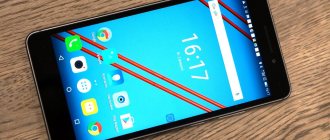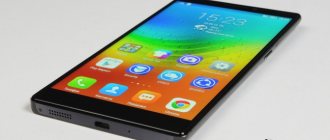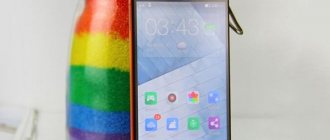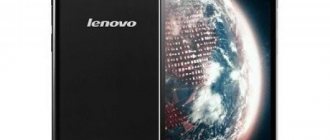It's 2021: budget Chinese smartphones are equipped with fingerprint scanners, Android 6 and 4000 mAh batteries. Lenovo also decided to make its mark by releasing the Lenovo Vibe C (A2020). Among the positive aspects of this model, we can only note support for 4G and not the most ancient version of the OS (Android 5.1).
Prices for Lenovo Vibe C in small, little-known online stores: 81 – 84 USD. To order a smartphone from a large, well-known store that issues a full one-year warranty, you will have to spend $100. This review contains information that reveals the main points regarding the operation of the device. It is highly desirable for everyone who is looking at this model to know about them.
Specifications Lenovo Vibe C (A2020)
Most of the characteristics (with the exception of 4G and OS version) are at the level of budget Chinese smartphones released in 2013.
Design, buttons, connectors
In terms of appearance, the plastic case is the most uncomplicated remnant. The model is most often found in a black body color, but you can also find a white version.
On the rear panel, in a single oval-shaped block, there is a camera with a flash. It's kind of like a double camera setup.
The touch keys for navigation are located under the screen and are not backlit. The MicroUSB connector and headphone input can be found on the top edge.
The power and volume keys have their usual location on the right side. Case dimensions: 143.5 x 71.8 x 8.95 mm. Weight: 166 g.
CPU
The smartphone uses a 4-core Qualcomm Snapdragon 210 8909 processor. Cortex-A7 cores operate at a maximum frequency of 1100 MHz. The Adreno 304 chip is installed as a video processor. The graphics chip is half behind the Adreno 320. But it is slightly ahead of its competitor Mali-400 MP4. Having tested the performance of hardware in Antutu, we get the following result: 21 thousand points.
Let's leave the numbers alone and move on to the real facts. The device copes with normal loads (like browsing websites in a browser) without any significant problems. That is, there is enough performance for everyday tasks. The picture with games is as follows. Budget SoCs from Qualcomm perform worse in games than similar solutions from MediaTek. For example, GTA: SA is quite playable on a smartphone with 1 GB of RAM and an MTK6580 chip. While Lenovo Vibe C can't handle this game.
As a result, even before this, simple graphics (adapted for specific hardware) must be manually reduced to a minimum. After that, minor freezes and drops in FPS will still remain, but the game will at least somehow work. But now Asphalt 8 and all sorts of “Pokemon” there will work normally.
Memory
The amount of RAM is 1 GB. Let's imagine that the smartphone will not be used to run 3D games. In this case, the amount of RAM can be considered quite adequate for this device.
The storage capacity for storing installed applications and user data is 8 GB. Not much free: 3.5 GB. But for ordinary applications this is sufficient. You can also connect a flash drive up to 32 GB.
Autonomous operation
Lenovo Vibe C received a removable battery with a capacity of 2300 mAh. Compared to the very economical hardware, the battery capacity seems very acceptable. The maximum playback time for YouTube videos (using a WiFi connection) is 6 hours.
In moderately active use mode, the smartphone lasts for a day and a half on a single charge. Users who use the device only when absolutely necessary note an increase in operating time to 2-3 days. Naturally, if you turn on 4G data and spend hours actively surfing the Internet, the charge level will decrease before your eyes.
Camera
The smartphone has a 5-megapixel camera without autofocus. Coming up with a scenario in which this camera could be useful is almost impossible. After all, even during the day with ideal lighting it is impossible to get even a more or less tolerable picture. Extremely low detail, solid soap all over the frame, pale colors.
An example of a daytime photo taken with the main camera of a Lenovo Vibe C A2020 smartphone
Both shots were taken in good daylight.
Demonstration of the capabilities of the main photomodule
There is no question of subject photography (text, etc.): the camera does not focus on objects at close range.
Product photography in daylight
Well, at least there is a flash. It can be used as a flashlight.
Close-up photography with flash
Probably for fun, ISO, shutter speed, and white balance settings have been added to the shooting application interface. Video recording is possible in HD resolution (720p). However, it is quite possible that the actual resolution is 480p (854 x 480), simply stretched by software. The quality of the videos is appropriate: terrible pixelation throughout the image. The front module allows you to take pictures with a resolution of 2 MP. I don’t want to mention it again, but... it’s not suitable for selfies. Only for video communication, nothing more.
Display
The diagonal of the installed screen is 5 inches. The modest display resolution (854 x 480) can somehow be forgiven. But not the technology used to make the matrix. In 2021, even noname manufacturers do not allow themselves to install TFT matrices in smartphones: most use IPS technology. The brightness reserve is sufficient for using the device indoors. But in the sun the image is faded, and there is a constant desire to increase the brightness. But it turns out that she was already at the maximum level.
Viewing angles are far from ideal. When tilted, the inversion of colors is clearly visible. Fortunately, if you look at the right angle, the image will be of acceptable quality. The sensor implements multi-touch technology, however, it supports a maximum of 2 simultaneous touches. Fortunately, this does not interfere with work. There is no light sensor, that is, automatic change of backlight brightness will not work.
Networking capabilities
You can install 2 SIMs in the device: Micro-SIM and Mini-SIM formats. Available networks: 2G, 3G and 4G LTE. Bluetooth version – 4.0, single-band WiFi. All of the above means of communication work flawlessly. Navigation: GPS, GLONASS available. The speed of searching for satellites and connecting to them is acceptable. The geopositioning accuracy is high; the device finds satellites not only in open space, but also indoors.
Sound
Both speakers (multimedia and conversational) have sufficient volume reserve. There are no complaints about the microphone’s performance, so the interlocutor will not complain about muffled speech. If you connect high-quality headphones, then the reproduced sound will be appropriate.
Software part
The manufacturer installed its own shell on top of Android 5.1.1 OS. It differs from the “pure” Android system, to a greater extent, in its modified interface. In particular, there is no button for calling all applications; instead, all icons are located on the desktop. There was also some “trash”. There’s not much built-in memory anyway, but the manufacturer still included several of its applications.
New middle class: review of the Lenovo Vibe Z2 smartphone
The Lenovo Vibe Z2 series smartphones - the 5.5-inch model and the 6-inch Z2 Pro - are a continuation of the flagship Z line. Both inherit the design of the once successful K900: angular body, high-quality metal, emphasis on the camera in the design of the rear panel. And of course, high performance and a decent display. But there is a small nuance: the display of the Vibe Z2 has HD resolution, and its processor is positioned as a mid-level solution. Although in real life the model makes a more pleasant impression than the typical average one priced at $400.
What is this?
Lenovo's dual-sim smartphone from the flagship Vibe Z line in a metal case with a high-capacity battery (3000 mAh), high performance, a 13-megapixel camera and a high-quality 5.5-inch IPS display, albeit with an unimpressive resolution of 720x1280 dots (267 ppi).
What else is he interested in?
Its 64-bit Snapdragon 410 processor is the first processor with such an architecture in the Qualcomm line.
And how is its performance and application performance?
Partly thanks to the power of the processor, partly thanks to the low screen resolution and its generous 2 GB of RAM, the Lenovo Vibe Z2 easily coped with any tasks that I assigned to it without delays, freezes, and especially glitches. The regular list of games - Temple Run 2, Real Racing 3, Dead Trigger 2, Asphalt 8 - was overcome effortlessly (sorry for the tautology). It swallowed a couple of dozen installed applications as if it had unlimited productivity resources. Although Lenovo is guilty of installing mountains of unnecessary software on its smartphones (games, Yandex services, applications of dubious usefulness), and after removing these applications a lot of resources are freed up, still, neither out of the box nor after installing even a bed of your favorite software, the user does not will receive a brooding metal block instead of a nimble gadget. The model had no problems with the smoothness of the interface. The smartphone's software (the gadget runs out of the box on Android 4.4.4, with Lenovo's proprietary launcher used on top of the OS) is perfectly adapted to the new processor. The only thing the model lacks to become a full-fledged new flagship is screen resolution. But even FullHD would reduce its performance.
I also had no problems installing and launching applications.
How long does he work?
Usually, when I take a smartphone for review, I disable all energy-saving functions on it - both the corresponding modes and any restrictions. I usually don’t use Bluetooth, mobile Internet only from time to time, but to track physical activity I turn on GPS and maximum accuracy in determining the location, and often turn the screen brightness to maximum manually (not all manufacturers can boast of correct operation of automatic backlighting in the sun in their gadgets. I usually take little photographs, listen to music for several hours a day, play mostly undemanding games for an hour or two, spend a couple of hours communicating in instant messengers and reading the Internet.In this mode, the Lenovo Vibe Z2 worked for me for a day and a half, which is 5 A .5-inch display and a 3000 mAh battery are not a record, but they are not a weak indicator either. The flagship Samsung Galaxy Note 4 and its two predecessors would have worked in such conditions a little longer, but I practically never let them out of my hands, and so For me, their batteries lasted a working day, a maximum of one and a half. But there were devices that held a charge weaker. If you turn on the energy-saving mode in the smartphone settings and use it with the same intensity, you will get two days of battery life.
What about the screen?
The Lenovo Vibe Z2's display deserves both compliments and criticism. Its strengths are high brightness, comfortable for viewing the screen on a sunny day (425.67 cd/m2), responsiveness, high-quality oleophobic coating, and the ability to change the color temperature in the settings. Weaknesses: not outstanding (although not bad, to be honest) calibration, low brightness in bright sunlight when automatic backlight adjustment is turned on (auto-adjustment is not brilliant, you have to turn it off and turn the brightness up to maximum), lack of support for working with gloves, low resolution. Although one can argue and argue regarding the resolution. In fact, HD is enough for such a diagonal (after all, it turns out to be 267 ppi), but since other smartphones from inexpensive brands already have FullHD for the same money, at this point we can safely complain that HD is now officially not enough for us.
| Device name | White field brightness, cd/m2 | Black field brightness, cd/m2 | Contrast |
| Lenovo Vibe Z2 | 425.67 | 0.57 | 742:1 |
| Lenovo Vibe X2 | 388.924 | 0.24 | 1648:1 |
| Meizu MX4 | 432.19 | 0.49 | 877:1 |
| Huawei Ascend P7 | 400.69 | 0.82 | 489:1 |
| Samsung Galaxy S5 | 370.3 | 0 | ∞ |
| HTC One M8 | 459.44 | 0.22 | 2088:1 |
| LG G2 | 336.41 | 0.4 | 840:1 |
| Sony Xperia Z1 | 400.81 | 0.75 | 534:1 |
| Huawei Ascend D2 | 310.52 | 0.30 | 1037:1 |
| iPhone 4S | 434 | 0.53 | 818:1 |
He looks good?
If you liked the design of the Lenovo K900, then you will also like the design of this model. I'm not a big fan of metallic shine and clean lines, the Lenovo Vibe X2 is more to my taste. But I admit that the smartphone looks nice and noble, and not at all cheap. The rear of the Vibe Z2 is covered with an all-metal plate, which also protects the long ends. And the short ones are covered with black plastic, it hides connectors and communication modules.
It feels good in the hand, but the back cover is a little slippery.
The camera sticks out a little, which, however, does not affect anything.
However, if you read our review of the Lenovo Vibe Z2 Pro, you won’t find anything new in this model. The design is the same, the dimensions are slightly smaller. The impressions from the case are similar.
What's new in the interface?
Everything you need to know about the interface of Lenovo smartphones can be gleaned from our reviews of the manufacturer’s previous models of the same generation:
- Smartphone for tuning. Lenovo Vibe X2 review
- Toughie. Lenovo Vibe Z2 Pro review
- Lenovo Yoga Tablet 2 8 review: learning new poses
Does he take good pictures?
Lenovo Vibe Z2 is equipped with a 13-megapixel camera with FullHD video recording, flash, autofocus and optical stabilization. Lenovo Vibe Z2 can also be classified as a selfie device - it has an 8-megapixel front camera. She takes great photos in low light, albeit slowly. By the light of a desk lamp, you can comfortably have a video call and do some decent self-talk. But I have complaints about the main camera. It shoots at an average level, inferior in quality to flagship smartphones, but still allowing you to take normal photos in normal lighting. But the problem is that, by the standards of today’s times, she shoots indecently slowly. Because of this, images often turn out blurry - either the hand will tremble, or a passerby will turn up at the wrong time. In general, see for yourself (and here - in original resolution).
What are the alternatives?
If you like the Lenovo brand, you can also pay attention to the Vibe X2. The smartphone has a chic body design, a higher quality display (with FullHD resolution and glove support). But it works a little less stable than Z2, so it’s more suitable for beautiful FIFA users than for picky geeks. Like the Z2, the X2 lacks support for memory cards and sports only a built-in 32 GB drive. Both smartphones are in the price category up to 8,000 hryvnia ($400).
With the current leapfrog with the exchange rate of the domestic currency, the price plays more against the new product than for it. Because for an additional thousand to one and a half hryvnia today you can already buy last year’s flagships: and those will have a more serious camera, a clearer screen, and even most likely with support for gloves, and a Snapdragon 800 series processor, the most powerful. Thus, LG G3 and HTC One (M8) are sold on the Internet for 9,000 hryvnia. Okay, HTC, its screen diagonal is half an inch smaller and the camera is not great. But the LG G3 is a very tempting candidate. Samsung fans will be able to afford the Galaxy Alpha for 9,000 hryvnia, and pragmatic HTC fans will be able to afford the hit of 2013, HTC One. But if your limit is 7.5-8 thousand hryvnia and Lenovo is among your favorite brands, you can safely take the Vibe Z2; in real life the smartphone is pleasant, even though the camera let it down.
Bottom line
Lenovo Vibe Z2 is an interesting and pleasant smartphone with a smart interface, balanced hardware and a noble body. It has one critical drawback - it is a slow camera. For some users, the lack of a microSD slot may also be a stumbling block, although the built-in memory allows you to not limit yourself in anything for a long time. If you prefer gadgets in a metal case, and would rather value a large diagonal and a smooth interface in a smartphone than a fast camera, then this model is for you. If photography is more valuable to you, and you have an extra 1-1.5 thousand hryvnia in your pocket, then it would be better to buy something from last year’s flagships.
4 reasons to buy Lenovo Vibe Z2:
- high performance and smooth interface;
- high capacity battery;
- metal case;
- bright screen with pleasant color rendering.
2 reasons not to buy Lenovo Vibe Z2:
- the camera is slow, very slow;
- no support for memory cards.
| Lenovo Vibe Z2 Specifications | |
| Display | IPS, 5.5 inches, 720×1280, 267 ppi, Gorilla Glass 3 |
| Frame | dimensions 140x69x7.3 mm, weight 120 g |
| CPU | 64-bit Qualcomm MSM8916 Snapdragon 410, 4 Cortex-A53 cores (1.2 GHz), Adreno 306 graphics |
| RAM | 2 GB |
| Flash memory | 32 GB |
| Memory card support | No |
| Camera | 13 MP, autofocus, flash, FullHD video recording, optical image stabilization, 8 MP front camera |
| Wireless technologies | Wi-Fi 802.11 b/g/n/ac (dual band, 2.4 and 5 GHz), Bluetooth 4.0 |
| GPS | GPS, GLONASS |
| Battery | 3000 mAh, non-removable |
| operating system | Android 4.4 + Vibe UI |
| SIM card | microSIM, two |
Specifications
The device is powered by an 8-core Mediatek MT6752 processor with a clock frequency of 1.7 GHz, 3 GB of RAM and 32 GB of internal memory. There is support for microSD memory cards with a capacity of up to 128 GB. The Mali-T760MP2 video accelerator is responsible for graphics processing.
The Lenovo Vibe S1 screen diagonal is 5 inches with a resolution of 1920 x 1080 pixels. The top of the display is covered with protective glass Corning Gorilla Glass 3.
The main highlight of the smartphone is its cameras. The main one has a resolution of 13 MP, but there are two front cameras - 2 and 8 MP. This allows you to separate the background from the main object, blur it, change it to another and apply all sorts of effects. This feature should appeal to selfie lovers.
The telephone module supports the operation of two Nano-SIM type SIM cards in standby mode. The second of which can be replaced with a microSD card to expand the internal memory. The smartphone works in GSM, WCDMA and LTE networks.
The dimensions of the device are 143.3 x 70.8 x 7.8 mm, and the weight is 132 grams. The smartphone runs on the Android 5.0 Lollipop operating system. In the AnTuTu test, the device produces 46,000 points.











